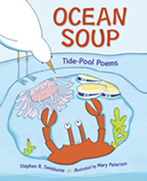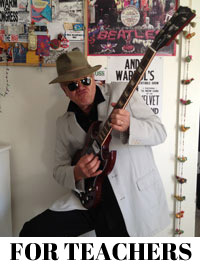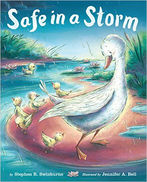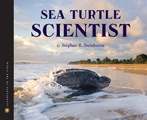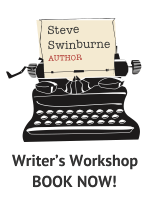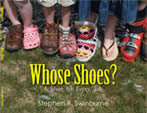Steve Swinburne
Children’s Book Author and School Visits
How to Propose, Research, and Write A Children's Nonfiction Nature Book
By Stephen Swinburne-South Londonderry, Vermont
In June, 1994 I walked away from a $50,000 a year job to write children's books.
With a mortgage, two young children, two old cars and my wife operating a struggling travel agancy, friends and family thought I was mad. But I had three things going for me: my foot in the door at a publisher with one book under contract, an amazing and supportive wife, and a ferocious determination to succeed.
Oh, one more thing. I chose to write about nature. There's an inexhaustible supply of things to write about in the natural world, and I couldn't afford writer's block. From the arctic to the rain forest, from the ocean to your backyard, there are stories waiting to be told. And you know what? Kids love reading about nature. They always have, and I think they always will.
The first step in writing nature books for kids is to keep a story file. I stuff ideas into a beat-up manila file inside my desk. Some are hastily written down on Post-it NotesTM; others are full-page descriptions on a legal yellow pad. All sorts of things go into my story file. I never know what one day might spark a book idea. Yesterday, I jotted down a quick note about a story I heard on National Public Radio. "New island found in the Caribbean. Species unknown to mankind. 100s of butterflies. Over a dozen scorpions." Your story file is your private stash, your idea safe deposit box, maybe even your money in the bank.
Eventually you'll stick an idea in your story file that won't let you go. It will follow you around in your head. It'll haunt you. And then you know you've found it; you've found the passion. Writing about something that you're passionate about makes all the difference.
As a writer of nonfiction nature books you need to keep your nose to the wind for good stories. In 1994, when the news broke that scientists were working on a plan to reintroduce gray wolves into Yellowstone National Park, I began a file of news clippings and magazine articles. Was there a book here? A trip to the library and local bookstore and a quick search on the Internet proved there were lots of good books about wolves for children already published. I studied many of these titles and asked myself how my book could be different. A few untouched topics began to emerge: no one had written about the persecution of the wolf throughout history, and no one had written about wolf reintroduction and the role scientists played in bringing back the gray wolf. Based on this discovery, I worked on an outline and wrote a sample chapter for a book that would eventually be called Once a Wolf-How Wildlife Biologists Fought to Bring Back the Gray Wolf.
In the summer of 1995, I mentioned my book idea to an editor to whom I had sold one book. She said she wanted to see it. As I knew this editor wanted to publish more books of mine and was showing a lot of interest in the wolf book, I decided to give her an exclusive submission. Well, nine months passed. In the interim, my editor left, and my wolf proposal was eventually returned. In this business you learn the hard way and the long way. Exclusive submissions are not all that they are cracked up to be.
I reworked my proposal, improving and updating it with new information that was coming out of the news. After 37 rejections, Houghton Mifflin called to say they wanted to publish it!
Sparks flew, angels sang, and I did a jig around the piles of books in my study.
After the euphoria wore off, I got down to work. Houghton had bought a proposal, not a finished book. I once worked for a photo editor at a magazine, so I took on the role of photo researcher. I would buy photo rights and secure permissions. You can aften negotiate a higher advance and better royalty if you research the photos for your book. It may take time and some out of pocket expense, but in the end it may be worth it. Completing a book is all about solving problems and answering editor's questions. If you consider yourself only a writer, give some thought to how your book might be illustrated.
For the next eight months, I ate, slept, and breathed wolves. I read over twenty books on wolves. I made daily visits to some ten wolf web sites on the Internet. I joined two wolf organizations. I flew to Yellowstone National Park and took a course in wolf biology and behavior. I corresponded with wolf biologists around the country. I ran up my phone bill calling places like the Montana Historical Society and the Smithsonian Institution searching for wolf photos. In short, I became a mini-expert. And you must do this with every nonfiction nature project you work on. Become a sponge and saturate yourself with information. Then sit down and write.
Just like the value of a good piece of real estate is in its "location, location, location," the strength of good nonfiction is in its research, research, research and its writing, rewriting, rewriting.
Research is living with your subject and learning as much as you can about your topic. Editors rely on you to get the facts right. And if your text isn't scientifically accurate some reviewer, teacher, librarian or biologist will find you out. While the facts about your natural history topic have to be impeccable, you can serve them up in a style that will fascinate and draw you reader in. Always tell a good story and make the bear, whale, bumblebee, hummingbird, whatever, come alive on the page.
For my book, Moon in Bear's Eyes, a reviewer wrote, "This attractive book describes the daily life of a grizzly bear family that lives in Yellowstone National Park ... and reads like an adventure story." I was pleased by that comment because I work very hard to tell a good story with a beginning, middle and end.
How do you make your nature topic come alive? How do you have your reader smell the forest floor, feel the salt spray of an ocean wind, or hear the wild call of a pileated woodpecker? Words. Good words. Good words in fresh and unique combinatoins that make compelling sentences and engaging paragraphs.
In Swallows in the Birdhouse, I showed how a tree swallow flies with the following sentence:
"The bird flies fast and strong and seems made of air, swerving and dipping like a leaf caught in a trick wind."
I want to connect to my readers through all of their senses. To show the enthusiasm of the swallow chicks, I wrote:
"If one of the parents nears the box, the nestlings know food is coming and make a loud racket like the hiss of fast rain on a dry sidewalk."
To show the urgency and spirit of migrations, I wrote:
"One day hundreds and hundreds of tree swalows crowd the telephone wires. The birds, wing to wing, flutter up and down, animated and anxious to begin their long migration. Over the meadows and fields, huge flocks wheel and turn. The air is alive with swallow wings and swallow voices." I believe striving for this kind of strong, rich text to describe natural processes in your nature book is not lost on children, teachers, parents, and, for that matter, reviewers. BOOKLIST made my hard work choosing the right words worth it when they wrote: "In Swallows in the Birdhouse Swinburne's lovely descriptive language details each part of the process in clear, simple prose, effectively using context to introduce readers to new vocabulary words." Amen.
When you've finished writing your story and have done your best job, send a fresh copy to a recognized expert in the field for their review. You want an objective pair of eyes looking at your manuscript and checking its factual accuracy. For example, before any editor read Moon in Bear's Eyes, I sent it to the chief bear biologist in Yellowstone National Park. His critical read pointed out one or two inaccuracies and saved me later embarrassment with my publisher. Of course, I acknowledged his assistance in reviewing my manuscript on the copyright page of the book.
Now four and a half years after I walked through those big brass doors and left behind that corporate job, I'm convinced it's the best thing I've ever done. I love my work as a children's book author. I love sharing my joy and enthusiasm for nature. Through my books and school visits, I want to encourage wonder, imagination and discovery.
If I've had any success it's because every day I'd look up at Winston Churchill's words written on an index card pinned above my computer: "Never give up, never give up, never give up." I haven't, and don't you!
About the Author: STEVE SWINBURNE, writer, photographer, and naturalist, is the author of many nature books for children, including Swallows in the Birdhouse, Moon in Bear's Eyes, Water for One, Water for Everyone (Millbrook), In Good Hands (Sierra Club), and Lots and Lots of Zebra Stripes-Patterns in Nature (Boyds Mills). His spring 1999 titles are: Safe, Warm and Snug (Harcourt Brace); Once a Wolf (Houghton Mifflin); Guess Whose Shadow? (Boyds Mills) and, in the fall, Unbeatable Beaks (Henry Holt). Steve visits schools throughout the country. His program called "From Blank Page to Book," where he takes kids on a tour of his books from original idea to printed book, is very popular. Steve is currently eating, sleeping and breathing coyotes for a book he's working on for Boyds Mills Press.
